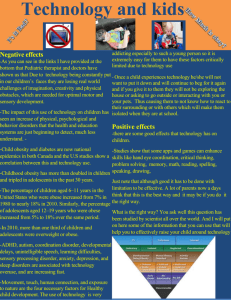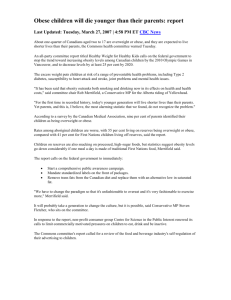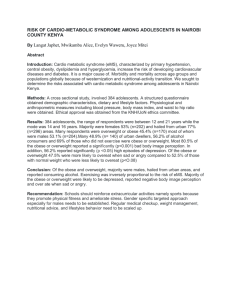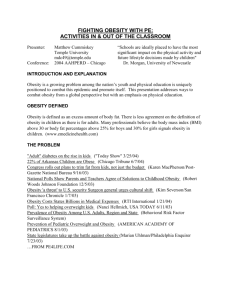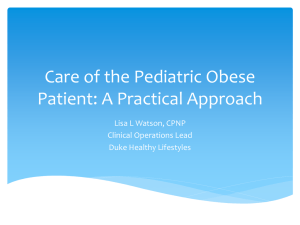Practical ideas for fighting obesity with Physical Education
advertisement
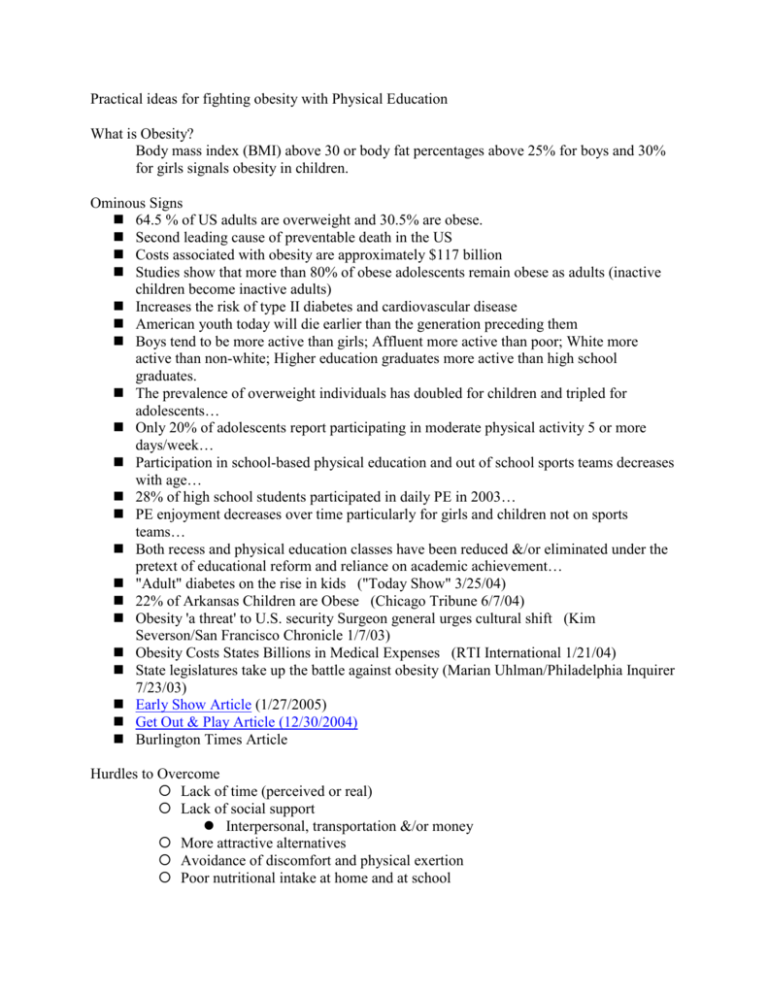
Practical ideas for fighting obesity with Physical Education What is Obesity? Body mass index (BMI) above 30 or body fat percentages above 25% for boys and 30% for girls signals obesity in children. Ominous Signs 64.5 % of US adults are overweight and 30.5% are obese. Second leading cause of preventable death in the US Costs associated with obesity are approximately $117 billion Studies show that more than 80% of obese adolescents remain obese as adults (inactive children become inactive adults) Increases the risk of type II diabetes and cardiovascular disease American youth today will die earlier than the generation preceding them Boys tend to be more active than girls; Affluent more active than poor; White more active than non-white; Higher education graduates more active than high school graduates. The prevalence of overweight individuals has doubled for children and tripled for adolescents… Only 20% of adolescents report participating in moderate physical activity 5 or more days/week… Participation in school-based physical education and out of school sports teams decreases with age… 28% of high school students participated in daily PE in 2003… PE enjoyment decreases over time particularly for girls and children not on sports teams… Both recess and physical education classes have been reduced &/or eliminated under the pretext of educational reform and reliance on academic achievement… "Adult" diabetes on the rise in kids ("Today Show" 3/25/04) 22% of Arkansas Children are Obese (Chicago Tribune 6/7/04) Obesity 'a threat' to U.S. security Surgeon general urges cultural shift (Kim Severson/San Francisco Chronicle 1/7/03) Obesity Costs States Billions in Medical Expenses (RTI International 1/21/04) State legislatures take up the battle against obesity (Marian Uhlman/Philadelphia Inquirer 7/23/03) Early Show Article (1/27/2005) Get Out & Play Article (12/30/2004) Burlington Times Article Hurdles to Overcome Lack of time (perceived or real) Lack of social support Interpersonal, transportation &/or money More attractive alternatives Avoidance of discomfort and physical exertion Poor nutritional intake at home and at school Media exposure including television, video games, and computers (OK to be the “fat” man) Lack of safe facilities Over-reliance on competition and organized sport CDC on High Quality PE Programs Modify the curriculum to increase both moderate and vigorous bouts of activity Increase the time allotted to physical education across all levels Switch to more active games &/or modified existing games and rules to enhance activity for all participants Active Youth recommends teacher focus on… Address the INTERESTS of students (what are they likely to participate in?) Hershey Food Recommendations Modify the school nutrition programs. Does the cafeteria offer healthy breakfast and lunch options? ($) Better yet, just healthy food? Are there healthy snacks and drinks in the vending machines? Most interventions increase activity (both intensity and duration) during class but many reported no change in out-of-school activity. Future programs need to aggressively promote out-of-school activity. Attempt more coordinated and comprehensive interventions involving schools, communities, and home settings. Involving Classroom Teachers Incorporate brief periods of stretching or activity in the classroom Provide nutrition lesson plans because many classroom teachers are not trained in health education (Create a district-wide standardized curriculum) Post information such as posters or models around the classroom After-School Activities Suggestions: Make it Fun!! Offer choices that appeal to a variety of student interests Include time for homework Target “at risk” population Provide non-competitive activities Think outside the box Collaborate with colleagues Steps Who’s interested, in what? Scheduling: days/week, # of weeks, session length Promotion of club to students and staff Permissions/transportation Equipment Planning each session (KISS) Funding…who’s getting paid and what plus equipment Activities: Mountain biking, cup stacking, recycling, chess, running drama club, snowshoeing, many others Specialized Classes Examples of specialized classes: Before school sessions During school physical education class in which obese or overweight children are “invited” to attend Modify the class specifically to obese children based on their needs and incorporate frequent body fat analyses, nutritional counseling, etc… Keep close track of progress Establish IEP’s when appropriate with a physician Miscellaneous Solutions Use pedometers, heart rate monitors, & other technologies to measure personal fitness. Incorporate student choice among category offerings (For example, two classes from team sports, three form wellness, two from individual sports, etc). Eliminate elimination games, maximize small-sided modified games (2 on 2 basketball), & reduce waiting time. Organize & participate in Jump Rope for Heart, Million Jump Day, field trips, ACES (all children exercising simultaneously), family nights, Fitnessgram awards for most improved, active lifestyle award, Walk to School and get extra PE, etc. Address the perceived competence (self-efficacy) of students in being able to succeed. Make the program as fun as possible to create positive attitudes & perceptions of physical activity Talk about benefits of physical activity and a reduction in their obesity level (listed later) Address access to school facilities run fitness center like a club (pass unit plus practical and written tests) Create a trifold or handout which is distributed to all students and ultimately the parents about obesity. Ask if the parents would like additional information in this area. Make frequent references to local physical activity resources Collect fitnessgram assessment data on children from 4th – 12th grade. Grade on the absolute score or improvement. Do not use physical activity as punishment Explain WHY they are learning any information Decorate the “naked gym” with the food pyramid, wellness scale, benefits of physical activity, bar graph of yards walked to burn off a big mac vs a grilled chicken sandwich, etc (Involve the art classes and make it interdisciplinary project) Community Solutions Fight for legislation to increase the time allocated to physical education Advocate for out-of-school athletic programs that are more “recreational-based” and inclusive rather than exclusive “competitive sport” programs Encourage greater walking and riding to school (making activity part of daily commute) “Walking School Bus” where volunteers coordinate walking routes to school (www.walkingschoolbus.org). Are there safe playgrounds, parks, and recreation facilities? Are school facilities open for use after school hours? Are there clearly marked walking and biking trails? Partnerships among businesses and other organizations can support programs that are accessible to all children and adolescents in the community Family Solutions Meet with the parents at school to formulate a strategy Dispense advice on variety and nutrition, exercise, and weight training (prepared handout) Broaching the topic initially can be difficult (get permission) Limit out-of-school “screen time” (TV, videogames, computer) Physical activity begins at home. Children and adolescents who are physically active usually have parents or other family members who encourage them to participate in physical activity, participate in physical activity with them, watch them play or compete, volunteer, and provide transportation to physical activity and sports events Be a role model by communicating positive and consistent messages (walk instead of drive a car, use the stairs, move the yard for exercise) Organize physical activities themselves with friends and family members Keep parents informed of progress and communicating successes, Create a network of social support (parents, friends, other adults…) Health Professionals Guest speakers and field trips Reinforce the importance of physical activity among physically active children and adolescents Establish partnerships with communities (e.g., child care facilities, schools, recreation centers) to raise awareness about the benefits of physical activity for children and adolescents, be positive role models, and serve as advocates for high-quality physical education programs (Kentucky Hospital System) Ask health care professionals to sponsor and support prevention activities (97% care, 3% prevention) Support 81 percent of teachers and 85 percent of parents favor requiring students to take physical education every day at every grade level 94 percent of teachers and 89 percent of parents favor developing new "lifestyle" approaches to physical education, focusing on activities children can continue to participate in after they've left school 87 percent of teachers and 88 percent of parents believe school boards should not eliminate physical education for budgetary reasons 87 percent of teachers and 77 percent of parents believe schools should not eliminate physical education classes to focus on meeting stricter academic standards
